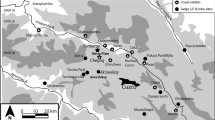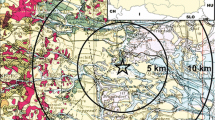Abstract
Zooarchaeological analysis conducted on remains recovered during two seasons of excavations at the Hacienda San Miguel Acocotla illuminates patterns of consumption among indigenous workers during the 19th century. Ethnographic research among modern butchers and at markets in Puebla, Cholula, and Atlixco, Mexico informs and contextualizes the results. When compared with data drawn from faunal remains on plantations in the United States, the results suggest that class analysis is of central importance to understandings of social dynamics of multiethnic sites throughout the Americas. In spite of this, some remains hint at the maintenance of pre-Columbian religious practices on the hacienda in the 19th century, suggesting that ethnicity was also salient to the inhabitants of the workers’ quarters at Acocotla.
Similar content being viewed by others
References
Alexander, Rani T. 2004 Yaxcabá and the Caste War of Yucatán: An Archaeological Perspective. University of New Mexico Press, Albuquerque.
Bauer, Arnold J. 2001 Goods, Power, History: Latin America’s Material Culture. Cambridge University Press, Cambridge, UK.
Baumann, Timothy 2004 African American Ethnicity. Archaeological Record: The Society for American Archaeology 4(4):16–20.
Behrensmeyer, Anna K. 1978 Taphonomic and Ecologic Information from Bone Weathering. Paleobiology 4(2):150–163.
Benavides Castillo, Antonio 1985 Notas sobre la arqueología histórica de la Hacienda Tabi, Yucatán (Notes on the Historical Archaeology of the Hacienda Tabi, Yucatán). Revista Mexicana de Estudios Antropológicos 31:45–58.
Binford, Lewis R. 1978 Nunamuit Ethnoarchaeology. Academic Press, New York, NY.
Brannon, Jeffery, and Gilbert M. Joseph 1991 Land, Labor & Capital in Modern Yucatán: Essays in Regional History and Political Economy. University of Alabama Press, Tuscaloosa.
Chance, John K. 2003 Haciendas, Ranchos, and Indian Towns: A Case Study from the Late Colonial Valley of Puebla. Ethnohistory 50(1):15–45.
Charlton, Thomas H. 1986 Socioeconomic Dimensions of Urban-Rural Relations in the Colonial Period Basin of Mexico. In Supplement to the Handbook of Middle American Indians, Vol. 4, Ethnohistory, Ronald Spores, editor, pp. 122–133. University of Texas Press, Austin.
2003 On Agrarian Landholdings in Post-Conquest Rural Mesoamerica. Ethnohistory 50(1):221–230.
Chevalier, François 1963 Land and Society in Colonial Mexico: The Great Hacienda. University of California Press, Berkeley.
Crader, Diana C. 1984 The Zooarchaeology of the Storehouse and the Dry Well at Monticello. American Antiquity 49(3):542–558.
1989 Faunal Remains from Slave Quarter Sites at Monticello, Charlottesville, Virginia. Archaeozoologia 3(1):229–236.
1990 Slave Diet at Monticello. American Antiquity 55(4):690–717.
DeFrance, Susan 1996 Iberian Foodways in the Moquegua and Torata Valleys of Southern Peru. Historical Archaeology 30(3):20–48.
Ferguson, Leland G. 1992 Uncommon Ground: Archaeology and Early African America, 1650–1800. Smithsonian Institution Press, Washington, DC.
Fournier-Garcia, Patricia 1997 Tendencias de Consumo en Mexico durante los Periodios Colonial e Independiente, (Patterns of Consumption in Mexico During the Colonial and Independence Periods). In Approaches to the Historical Archaeology of Mexico, Central and South America, Vol. 38, Janine Gasco, Greg C. Smith, and Patricia Fournier-Garcia, editors, pp. 49–58. Institute of Archaeology, University of California Press, Los Angeles.
Fournier-Garcia, Patricia, and Lourdes Mondragon 2003 Haciendas, Ranchos, and the Otomi Way of Life in the Mezquital Valley, Hidalgo, Mexico. Ethnohistory 50(1):47–68.
Gifford, Diana P., and Diana C. Crader 1977 A Computer Coding System for Archaeological Faunal Remains. American Antiquity 42(2):225–238.
Hanna, Katherine A. 1954 The Roles of the South in the French Intervention in Mexico. Journal of Southern History 20(1):3–21.
Jamieson, Ross W. 2008 The Market for Meat in Colonial Cuenca: A Seventeenth-Century Urban Faunal Assemblage from the Southern Highlands of Ecuador. Historical Archaeology 42(4):31–37.
Jarquín, María Teresa, Colegio Mexiquense, Universidad Iberoamericana, and Instituto Nacional de Antropología e Historia 1990 Origen y evolución de la hacienda en México: siglos XVI al XX (Origin and Evolution of the Hacienda in Mexico: 16th to 20th Centuries). Instituto Nacional de Antropología e Historia, Mexico City, Mexico.
Jones, David 1981 The Importance of the Hacienda in 19th Century Otumba and Opan, Basin of Mexico. Historical Archaeology 15(2):87–116.
Jones, Sian 1997 The Archaeology of Ethnicity: Constructing Identities in the Past and Present. Routledge, New York, NY.
Juli, Harold 2003 Perspectives on Mexican Hacienda Archaeology. The SAA Archaeological Record 3(4):23–24.
Klippel, Walter E. 2001 Sugar Monoculture, Bovid Skeletal Part Frequencies, and Stable Carbon Isotopes: Interpreting Enslaved African Diet at Brimstone Hill, St. Kitts, West Indies. Journal of Archaeological Science 28(11):1,191–1,198.
Landon, David 2005 Zooarchaeology and Historical Archaeology: Progress and Prospects. Journal of Archaeological Method and Theory 12(1):1–36.
Lyman, Richard L. 1994 Quantitative Units and Terminology in Zooarchaeology. American Antiquity 59(1):36–71.
McGuire, Randall H., and Robert Paynter 1991 The Archaeology of Inequality. Blackwell, Cambridge, UK.
McKee, Lawrence 1987 Delineating Ethnicity from the Garbage of Early Virginians: Faunal Remains from the Kingsmill Plantation Slave Quarter. American Archaeology 6(1):31–39.
1992 The Ideals and Realities Behind the Design and Use of 19th Century Virginia Slave Cabins. In The Art and Mystery of Historical Archaeology: Essays in Honor of James Deetz, Anne E. Yentsch and Mary C. Beaudry, editors, pp. 195–213. CRC Press, Boca Raton, FL.
Meyers, Allan 2001 Community, Household, and Status at Hacienda Tabi, Yucatan, Mexico. Doctoral disseration, Department of Anthropology, Texas A&M University. University Microfilms International, Ann Arbor, MI.
2005 Material Expressions of Social Inequality on a Porfirian Sugar Hacienda in Yucatan, Mexico. Historical Archaeology 39(4):112–137.
Meyers, Allan, and David L. Carlson 2002 Peonage, Power Relations, and the Built Environment at Hacienda Tabi, Yucatan, Mexico. International Journal of Historical Archaeology 6(4):225–252.
Mintz, Sidney W. 1996 Tasting Food, Tasting Freedom: Excursions into Eating, Culture, and the Past. Beacon Press, Boston, MA.
Mörner, Magnus 1973 The Spanish American Hacienda: A Survey of Recent Research and Debate. Hispanic American Historical Review 53(2):183–216.
Newman, Elizabeth T. 2009 San Miguel Acocotla: The History and Archaeology of a Central Mexican Hacienda. Doctoral dissertation, Department of Anthropology, Yale University. University Microfilms International, Ann Arbor, MI.
Newman, Elizabeth T., and Harold D. Juli 2008 Historical Archaeology and Indigenous Identity at the Ex-Hacienda San Miguel Acocotla, Atlixco, Puebla, Mexico. Foundation for the Advancement of Mesoamerican Studies, Crystal River, FL <http://www.famsi.org/reports/06010/index.html>.
Orser, Charles E. 1988 The Archaeological Analysis of Plantation Society: Replacing Status and Caste with Economics and Power. American Antiquity 53(4):735–751.
Paynter, Robert 1988 Steps to an Archaeology of Capitalism: Material Change and Class Analysis. In The Recovery of Meaning: Historical Archaeology in the Eastern United States, Mark P. Leone and Parker B. Potter, editors, pp. 407–433. Smithsonian Institution Press, Washington, DC.
Peloso, Vincent C. 1985 Succulence and Sustenance: Region, Class, and Diet in Nineteenth-Century Peru. In Food, Politics, and Society in Latin America, Latin American Studies, John C. Super and Thomas C. Wright, editors, pp. 46–64. University of Nebraska Press, Lincoln.
Peres, Tanya M. 2008 Foodways, Economic Status, and the Antebellum Upland South in Central Kentucky. Historical Archaeology 42(4):31–37.
Pilcher, Jeffrey M. 1998 ¡Que Vivan Los Tamales!: Food and the Making of Mexican Identity. University of New Mexico Press, Albuquerque.
Plunket, Patricia 1990 Arqueología y etnohistoria en el Valle de Atlixco (Archaeology and Ethnohistory in the Valley of Atlixco). Notas Mesoamericanas 12:3–18.
Reitz, Elizabeth J. 1989 The Spanish Colonial Experience and Domestic Animals. Historical Archaeology 26(1):84–91.
Reitz, Elizabeth J., Tyson Gibbs, and Ted A. Rathbun 1985 Archaeological Evidence for Subsistence on Coastal Plantations. In The Archaeology of Slavery and Plantation Life, Theresa A. Singleton, editor, pp. 163–191. Academic Press, San Diego, CA.
Reitz, Elizabeth J., and Elizabeth S. Wing 1999 Zooarchaeology. Cambridge Manuals in Archaeology. Cambridge University Press. Cambridge, UK.
Reitz, Elizabeth J., and Martha A. Zierden 1991 Cattle Bones and Status from Charleston, South Carolina. In Beamers, Bob-Whites, and Blue-Points: Tributes to the Career of Paul W. Parmalee, Illinois State Museum Scientific Papers, Vol. 23, James R. Purdue, Walter E. Klippel, and Bonnie W. Styles, editors, pp. 396–407. Illinois State Museum, Springfield.
Rodríguez-Alegría, Enrique 2005 Eating Like an Indian: Negotiating Social Relations in the Spanish Colonies. Current Anthropology 46(4):551–573.
Rodríguez, Ileana (editor) 2001 The Latin American Subaltern Studies Reader. Duke University Press, Durham, NC.
Romano, Mary Carmen 2005 San Miguel Acocotla, Atlixco: Los Voces y la Historia de una Hacienda Triguera (San Miguel Acocotla, Atlixco: The Voices and History of a Wheat Hacienda). Bachelor’s thesis, Department of Anthropology, Universidad de las Americas-Puebla, Puebla, Mexico.
Schultz, Peter D., and Sherri M. Gust 1983 Faunal Remains and Social Status in 19th Century Sacramento. Historical Archaeology 17(1):43–53.
Scott, Elizabeth 1996 Who Ate What?: Archaeological Food Remains and Cultural Diversity. In Case Studies in Environmental Archaeology, Interdisciplinary Contributions to Archaeology, ELIZABETH J. REITZ, LEE A. NEWSOM, and SYLVIA J. SCUDDER, editors, pp. 357–374. Plenum Press, New York, NY.
Silliman, Stephen W. 2004 Lost Laborers in Colonial California: Native Americans and the Archaeology of Rancho Petaluma. University of Arizona Press, Tucson.
Singleton, Theresa A. 1985 The Archaeology of Slavery and Plantation Life. Academic Press, Orlando, FL.
1995 The Archaeology of Slavery in North America. Annual Review of Anthropology 24:119–140.
Smith, Monica L. 2006 The Archaeology of Food Preference. American Anthropologist 108(3):480–493.
Taylor, William B. 1972 Landlord and Peasant in Colonial Oaxaca. Stanford University Press, Stanford, CA.
Trigg, Heather, David Landon, Elizabeth Newman, and Anne Hancock 2003 Archaeobiological Materials Analysis. In Supplementary Excavations at the Kirk Street Agents’ House, Lowell National Historical Park, Lowell Massachusetts, William A. Griswold, editor, pp. 27–41. National Park Service, Lowell, MA.
Van Young, Eric 1983 Mexican Rural History Since Chevalier: The Historiography of the Colonial Hacienda. Latin American Research Review 18(3):5–61.
Wheaton, Thomas R., and Patrick H. Garrow 1985 Acculturation and the Archaeological Record in the Carolina Low Country. In The Archaeology of Slavery and Plantation Life, Theresa A. Singleton, editor, pp. 239–259. Academic Press, Orlando, FL.
Wiessner, Polly 1996 Introduction. In Food and the Status Quest: An Interdisciplinary Perspective, Polly Wiessner and Wulf Schiefenhövel, editors, pp. 1–18. Berghahn Books, Providence, RI.
Yentsch, Anne E. 1992 Gudeons, Mullet, and Proud Pigs: Historicity, Black Fishing, and Southern Myth. In The Art and Mystery of Historical Archaeology: Essays in Honor of James Deetz. Anne E. Yentsch and Mary C. Beaudry, editors, pp. 283–314. CRC Press, Boca Raton, FL.
1994 A Chesapeake Family and Their Slaves: A Study in Historical Archaeology. Cambridge University Press, Cambridge, UK.
Zeitlin, Judith F. 2005 Cultural Politics in Colonial Tehuantepec: Community and State Among the Isthmus Zapotec, 1500–1750. Stanford University Press, Stanford, CA.
Zeitlin, Judith F., and Elizabeth T. Newman 2005 Domestic Animals in Domestic Spaces: The Indigenization of Pastoral Economies in Colonial Mexico. Paper presented at the 38th Conference on Historical and Underwater Archaeology, York, UK.
Author information
Authors and Affiliations
Rights and permissions
About this article
Cite this article
Newman, E.T. Butchers and Shamans: Zooarchaeology at a Central Mexican Hacienda. Hist Arch 44, 35–50 (2010). https://doi.org/10.1007/BF03376793
Published:
Issue Date:
DOI: https://doi.org/10.1007/BF03376793




